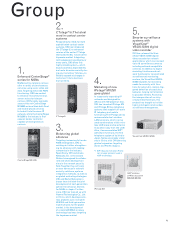Oki 2007 Annual Report Download - page 18
Download and view the complete annual report
Please find page 18 of the 2007 Oki annual report below. You can navigate through the pages in the report by either clicking on the pages listed below, or by using the keyword search tool below to find specific information within the annual report.
Giving More to Society through Advanced Technologies
OKI has become the fi rst in the world to successfully develop and commercialize Epi Film
Bonding (EFB) technology, which is able to bond thinned materials on top of dissimilar materials
without the use of adhesives by taking advantage of the phenomenon known as intermolecular
bonding force. EFB can be safely peeled from surfaces without causing blemishes, bonded to
different raw materials, and integrated into semiconductor processes. This technology dispens-
es with the need for wire bonding that was previously necessary for dissimilar materials and has
reduced the number of chips used in electronic devices. EFB technology endows increasingly
dense, multi-layered semiconductors with faster speeds and lower power consumption, which
opens up many possibilities in developing a variety of IC devices.
OKI has applied its proprietary EFB technology to create a new type of LED print-head for
printers. Thinned LED array chips and driver IC chips that have been integrated using intermo-
lecular bonding force are, as a single unit, half the size of conventional LED print-heads. EFB
technology also contributes to lowering fabrication and material costs, thereby improving cost
effi ciency. These heads debuted in the C3400n, a compact, high-speed color LED printer, and will
be featured in subsequent OKI color and monochrome LED printers. By developing this tech-
nology, OKI plans to develop ultra small print-heads and heads with 1200dpi or more to enable
higher resolution printing.
OKI will use this technology to further its research into smaller, lower cost ICs that consume
less power as well as to realize developments such as ultra-compact LED displays. Recognizing
this technology’s potential, OKI has launched a Group-wide research unit to investigate adapt-
ing this technology in other fi elds.
Thinned LED and driver
IC integrated with EFB
technology
Conventional LED print-head
New LED print-head
5. Smart Mechatronics: Advanced infrastructures for using
ubiquitous services based on OKI’s well-developed mecha-
tronics know-how, such as ATM systems and printers.
6. Ubiquitous Devices: Technology that makes ubiquitous
infrastructures possible. OKI utilizes semiconductor and com-
ponent technology capabilities gained by concentrating on the
development of personal and mobile devices.
OKI maximizes effi ciency in its R&D efforts by delegating
basic research functions to its Corporate Research and De-
velopment Center and entrusting product development to the
development departments of each in-house company. To cre-
ate advanced technologies, commercialize products fl exibly
and rapidly, and link basic research with product development,
OKI has established the Business Incubation Division within
the Systems Network Group under the Info-telecom Systems
segment. By promoting Group-wide project cooperation, OKI is
accelerating the creation of new technologies and businesses.
Research at the level of elemental technology development is
promoted through business-academia collaborations.
Research and Devel
Ubiquitous Services—able to satisfy user demands to obtain
information, products, and services wherever, whenever and
with whatever—continue to expand as the e-Society evolves.
OKI supports the development of this e-Society by pushing
the boundaries of R&D in six specifi c areas to provide leading
Ubiquitous Services.
Six Areas of Technological Development in
Provision of Ubiquitous Services
1. Ubiquitous Networks: Technology that provides individu-
als with freedom of activity, anytime and anywhere. OKI engag-
es in the development of technologies for NGNs, industry-lead-
ing IP networks, and advanced wireless and sensor networks.
2. Network Dependability: Technology that provides in-
dividuals the secure use of safe, authentic services, such as
biometric identifi cation systems and security technology for
network-based settlement.
3. Rich Media: Technology that allows individuals to precisely
obtain the desired services and data, in the right format, in-
cluding technology that smoothly delivers video images and
integrates telecommunications and broadcasting.
4. Customer Concierge: Technology that offers individuals
services to meet their precise needs, including administrative
applications and electronic ticketing systems as well as ITS
developments for the private sector.
World’s First Mass Producer of Thin-Film Bonding Technology for Dissimilar Materials
17 Annual Report 2007
























